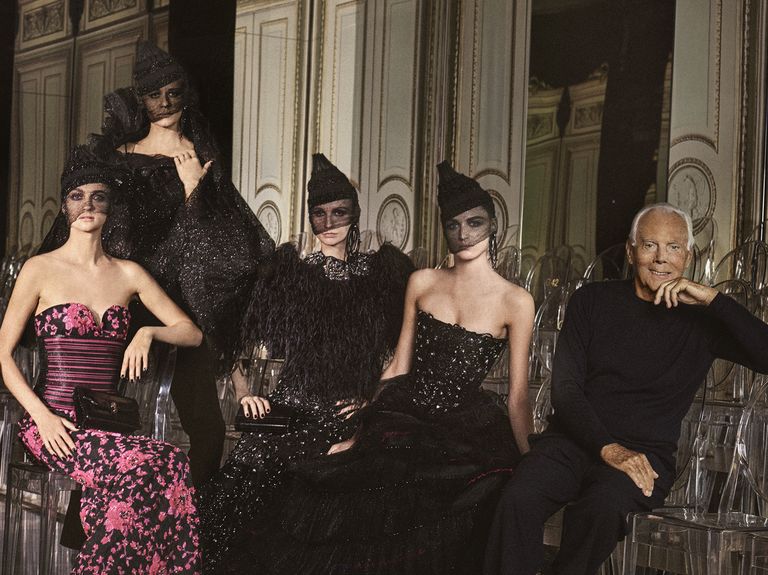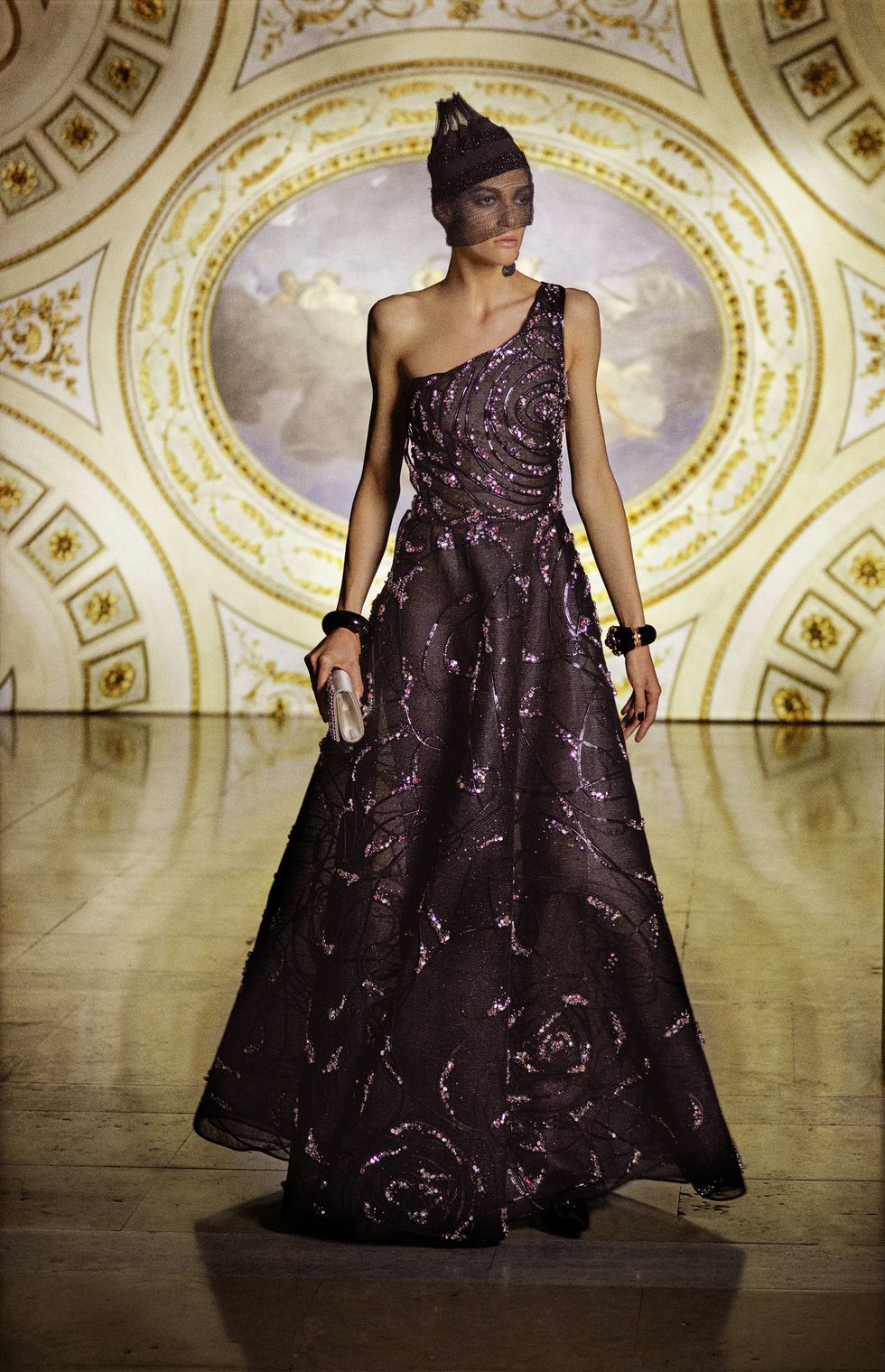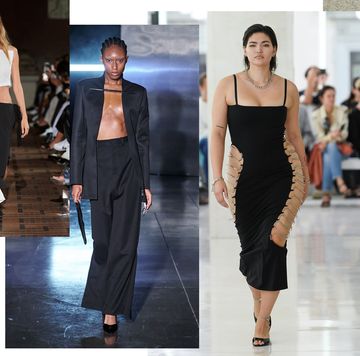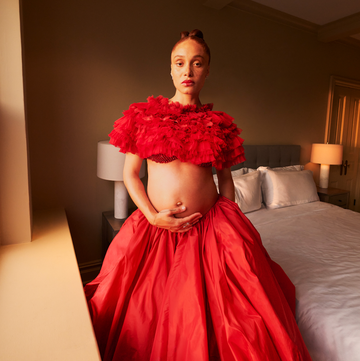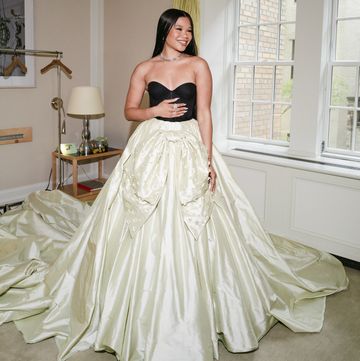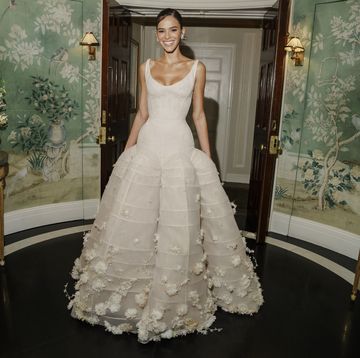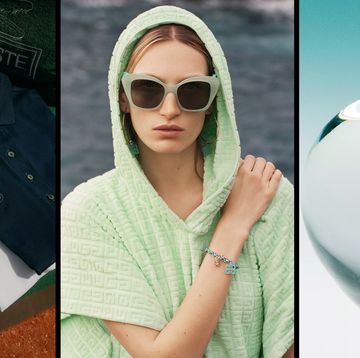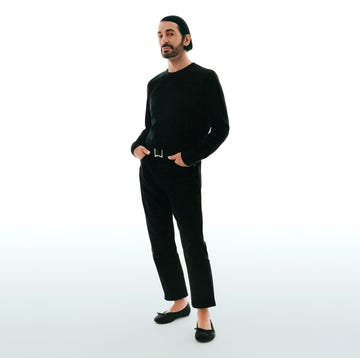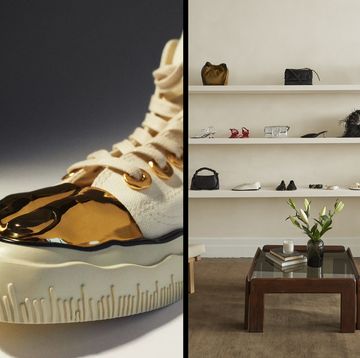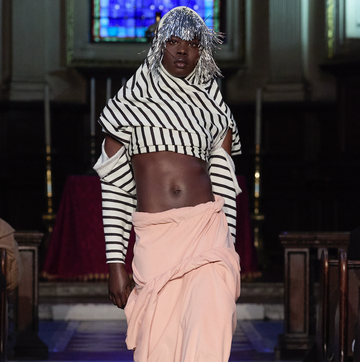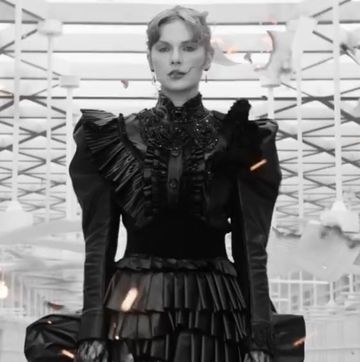Early in the morning before Giorgio Armani’s latest couture show in Paris, the maestro is as calm as always, at work with his team in an atelier lined with wardrobe rails of flowing black gowns that make up a significant part of the collection. Every feature is exquisite—intricate crystal beading and embroidery; clouds of dark feathers; fluid layers of tulle and sinuous velvet—while Mr. Armani, watchful and alert as an orchestral conductor, makes his final adjustments to create an elegant symphony that is the purest expression of his prevailing vision of beauty.
At 83, he looks remarkably healthy: tanned, trim, and dressed in his signature uniform of a midnight-blue T-shirt and navy trousers. His steady gaze notices everything—as soon as we have greeted one another, he has already taken in the details of what I am wearing (flat ballet pumps, a floral chiffon blouse, and jeans). He refers to these almost immediately, when I ask him about his decision to stage his latest Emporio Armani show during London Fashion Week (to coincide with the reopening of his Bond Street store). “I’ve been away from London for quite some time,” he says. “The city has changed, I’ve changed, and fashion has changed. But what has stayed the same is my desire to express myself. Because in this rapidly changing world, you can be influenced, dragged in one direction or another, and lose your own identity. But I have eyes and ears; I look around and listen, and I’ve noticed that you wear jeans in a beautiful way, which maybe 10 years ago you wouldn’t have done. So this is what it means, this is the London of 2017, 2018. And now I consider London to be more sophisticated, perhaps, than before.” Sophistication is, of course, the essence of Armani style, ever since he first launched his brand in 1975, with a singularity that has made him that rarest of contemporary designers: the president and owner of his own business—with a personal fortune of more than $8 billion—and a true independent in an era of global conglomerates. And somehow he has made this near impossible feat seem easy, just as he makes his characteristically understated tailoring look effortless. But it’s worth remembering just how radical this was at the beginning of his career, when he deconstructed the rigid lines of traditional jackets, honing a soft yet streamlined version of androgynous suiting that bestowed a supple grace upon those who chose to wear Armani, whether at work or at play.
Like Coco Chanel—a couturier he admires greatly, along with Yves Saint Laurent—Armani has an aptitude for creating simplicity that belies the complexity of his talent, inspiration, and ambition. And again like Chanel, the polished surfaces of his self-made empire may also conceal past struggles and hidden depths. “I’m very tough on myself—even more so than on those around me,” he observed in a memoir published in 2015. And his life was challenging from the start, for he was born during the Depression, in July 1934, and grew up under the shadow of Mussolini’s fascist dictatorship, in the northern Italian city of Piacenza, which suffered intensive bombing during World War II. In his memoir, Armani recalled “the fear of [living in] a bombed-out city, sheltering in cellars,” and in previous conversations, he has told me about the privations of the war and its aftermath, when “there was no money and nothing to eat.” The middle child of three, he had an older brother (Sergio, now dead)and a younger sister, Rosanna; his father was employed by a transport company, and then arrested and imprisoned for several months after the war, on charges of having worked for the fascist state. His mother, a housewife who also organized children’s summer camps, was a beautiful, dignified yet austere presence; a naturally elegant woman, he says, but one to whom outward displays of affection did not come easily.
After enduring a long spell in the hospital—the result of a childhood trauma during the war, when he was badly burned by an exploding shell—Armani nurtured an early ambition to become a doctor. He spent three years studying medicine, followed by two years of compulsory military service, but eventually decided that he needed to get a job to help support his family. He found work at a department store in Milan, La Rinascente, initially as a window dresser, then as a menswear buyer. “The first time I visited London, I was still working for La Rinascente,” he recalls, “and it was the provocative London of Carnaby Street. I didn’t speak English, and coming from the Italian suburbs, I was a bit shocked. But I was very struck by it, in a good way.”
Armani eventually moved into fashion design, employed by the Italian textile magnate Nino Cerruti, but it was not until he turned 40 that he felt able to contemplate launching his own brand. And even then, this only came about because of the love and support of his partner, Sergio Galeotti, who encouraged Armani to take the risk of setting up in business. Success was swift, in part because the subtle androgyny of the Armani look proved to be the ideal sartorial choice for a new generation of working women for whom feminism did not preclude fashion. But there was also something else at play in the rise of Armani—a sexiness that tends to be forgotten by those who dubbed him the king of greige. Consider the integral role played by Armani tailoring in in which Richard Gere is even more seductive when filmed getting dressed in his softly fitted suits than he is naked. Here, then, are clothes as a second skin, and with a similar intimacy and caressing touch.
I wonder too about how Armani’s own sexual identity may have influenced his work, for he grew up in a period when fascism sought to suppress homosexuality (and even though such persecution is no longer sanctioned by the state in Italy, it is not yet a country that fully embraces gay rights). Certainly there is nothing camp about Armani style; hence, perhaps, the way that his menswear has been used to great effect by Hollywood filmmakers, to suggest the hypermasculinity of gangster roles in and but as is also evident in this may not preclude a subversive homoerotic undercurrent, whatever the apparent intentions of the director.
Tragically, Armani’s rise to success was darkened by Galeotti’s death from AIDS in 1985. This terrible loss might have seemed insurmountable, given that Galeotti was Armani’s business partner as well as his life’s companion and inspiration. But the designer’s inner strength—even a streak of steeliness—manifested itself with sufficient intensity to propel the company to even greater heights. “Challenges: I love them more than anything else,” he wrote in his memoir, though it is also clear that he grieved long and deeply. When I interviewed Mr. Armani two years ago, on the occasion of the 40th anniversary of his company, he observed: “To be creative, you need to be able to respond to pain. If everything goes well, you get boring.” All of which makes Armani—the man and the brand—more complicated than one might at first assume. Just look at the unexpected dash of playfulness that is evident in his work; in this couture collection, for example, there are little knitted hats, and occasional splashes of vivid pink, and a print that suggests a bird in flight, its wings spread wide. “Nowadays, everything blends together,” says Mr. Armani, “so with this collection I wanted to create a clear divide, and to reaffirm the true codes of couture, which are sophistication, eccentricity, and uniqueness.”
Eccentricity may seem like a surprising element in an aesthetic famed for its sophistication and elegant restraint, but it’s nevertheless a key ingredient of Armani style. (Which may explain the presence of a larger-than-life gorilla in Mr. Armani’s living room on the top floor of his palazzo in Milan, a discarded model from Italy’s Cinecittà film studio that he has given a home.) As the designer himself observes, the clarity of his visual approach is leavened with “a touch of modernity and wit.” Added to these are his imagination and the power of dreams. “My family was a modest family with modest opportunities,” he says, “so I basically constructed a world for myself. And that’s why I love this job so much, because it has allowed me to build a world to which I never belonged—a world that I saw in films, and that I read about in books. I built my own way of being .”
Perhaps surprisingly for someone who claims not to speak English (although he appears to understand everything I say during the course of our conversation, even before it is translated), Mr. Armani is a great fan of British period drama, including and “There’s a representation of a world and a way of being that I love very much,” he says. “There’s one way of dressing for breakfast, another for dinner, and clothes depending on the various circumstances that presented themselves throughout the day. But nowadays, you put on something in the morning, and you only take it off when you go to bed at night.”
He looks almost wistful for a moment, as if contemplating this idealized English past has lessened his usual guardedness. And so I ask him, “What did you dream about last night?”
“It was a horrible dream,” he says. “I was in New York with some unidentifiable people, and at a certain point I turned around and they weren’t there anymore. I’m lost in New York, in a department store that is closing, it’s raining outside, and I’m feeling so distressed, completely abandoned.”
“It’s a recurring dream—if I told a psychoanalyst about it, they’d say, ‘You’re scared that people are going to abandon you.’ ” He smiles and adds, “Fortunately, I woke up in my own beautiful bedroom.”
“Have you ever had psychoanalysis?” I ask.“I did it myself!” he replies. Then he says goodbye, with a gentle nod, and his eyes—sky blue yet grave—return to the task ahead of him: to the rails of enchanting couture gowns, and a waking dream of pure elegance, wherein the continuing search for perfection offers the hope of overcoming each and every fear of loss.
Justine Picardie is the editor in chief of Harper’s Bazaar UK; This article originally appears in the October issue of Harper's Bazaar.
Lead image: Giorgio Armani with models wearing couture gowns from his Armani Privé Fall 2017 collection, photographed at the Palais de Chaillot in Paris. All clothing and accessories, Armani Privé.
